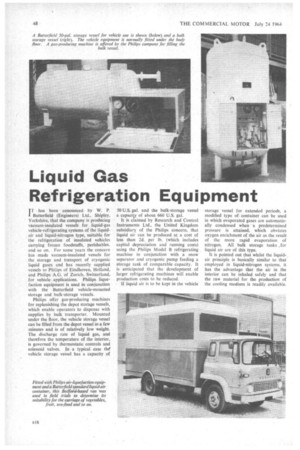Liquid Gas Refrigeration Equi pment
Page 50

If you've noticed an error in this article please click here to report it so we can fix it.
IT has been announced by W. P. I Butterfield (Engineers) Ltd., Shipley, Yorkshire, that the company is producing vacuum-insulated vessels for liquid-gas vehicle-refrigerating systems of the liquidair and liquid-nitrogen type, suitable for the refrigeration of insulated vehicles carrying frozen foodstuffs, perishables, and so on. For some 'years the concern has made vacuum-insulated vessels for the storage and transport of cryogenic liquid gases and has recently supplied vessels to Philips of Eindhoven, Holland, and Philips A.G. of Zurich, Switzerland, for vehicle applications. Philips liquefaction equipment is used in conjunction with the Butterfield vehicle-mounted storage and bulk-storage vessels.
Philips offer gas-producing machines for replenishing the depot storage vessels, which enable operators to dispense with supplies by bulk transporter. Mounted under the floor, the vehicle storage vessel can be filled from the depot vessel in a few minutes and is of relatively low weight. The discharge rate of liquid gas, and therefore the temperature of the interior, is governed by thermostatic controls and solenoid valves. In a typical case the vehicle storage vessel has a capacity of
50 U.S. gal. and the bulk-storage vessel a capacity of about 660 U.S. gal.
It is claimed by Research and Control Instruments Ltd., the United Kingdom subsidiary of the Philips concern, that liquid air can be produced at a cost of less than 2d. per lb. (which includes capital depreciation and running costs) using the Philips Model B refrigerating machine in conjunction with a snow separator and cryogenic pump feeding a storage tank of comparable capacity. It is anticipated that the development of larger refrigerating machines will enable
production costs to be reduced. .
If liquid air is to be kept in the vehicle • storage vessel for extended periods, a modified type of container can be used in which evaporated gases are automatically condensed when • a predetermined pressure is attained, which obviates oxygen enrichment of the air as the result of the more rapid evaporation of nitrogen. All bulk storage tanks for liquid air are of this type.
It is pointed out that whilst the liquidair principle is basically similar to that employed in liquid-nitrogen systems, it has the advantage that the air in the interior can be inhaled safely and that the raw material for the production of the cooling medium is readily .available,
















































































































